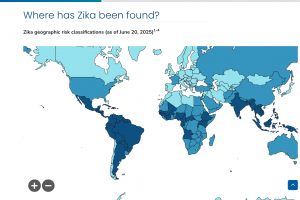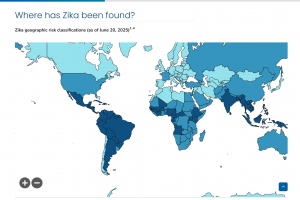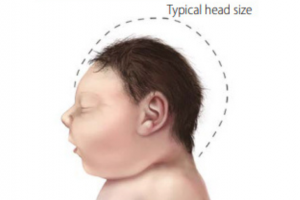Zika Vaccines
Zika Virus Vaccine Candidates December 2025
Developing a safe and efficacious Zika vaccine and monoclonal antibody (mAb) is a global health priority, says the World Health Organization (WHO). However, as of December 2025, the U.S. Food and Drug Administration (FDA), Brazil, the European Medicines Agency (EMA), and the United Kingdom have not approved any Zika vaccine or mAb. A series of papers summarizes the key challenges and knowledge gaps that must be addressed to advance Zika vaccine research. As of 2025, a review identified 16 Zika vaccine candidates in Phase 1 or 2 trials, and three monoclonal antibodies (mAbs) were in Phase 1 trials. Zika vaccine clinical trials involving a DNA-based, modified vaccinia Ankara vector platform and purified inactivated vaccine candidates (January 2023, May 2023, October 2023) demonstrate that these vaccine candidates can induce Zika-neutralizing monoclonal antibodies.
Since 2016, approximately $350 million in research funding for a Zika vaccine has been mobilized (Chapman et al., 2020; U.K.'s Newton Fund, U.S. HHS). The U.S. National Institute of Allergy and Infectious Diseases (NIAID) is developing multiple vaccine candidates to prevent Zika infection.
France-based Valneva SE's VLA1601 is the most advanced Zika vaccine candidate. It is a second-generation, highly purified, inactivated, adjuvanted vaccine candidate adsorbed on aluminum hydroxide. On March 26, 2024, Valneva Austria GmbH announced the initiation of an additional two-dose, Phase 1 clinical trial (VLA1601-102), with initial results posted on November 4, 2025.
ZPIV is a Zika virus vaccine candidate with a purified, formalin-inactivated Zika virus. In June 2023, a study found that ZPIV was well tolerated in flavivirus-naïve and previously vaccinated adults; the immunogenicity of ZPIV in bats varied significantly by flavivirus vaccination status. Immune bias towards the flavivirus antigen of initial exposure and the timing of vaccination may have impacted responses. In this Phase 1 clinical trial, a third ZPIV dose significantly reduced, but did not eliminate, the immunogenicity discrepancy.
TAK-426 (PIZV) is a purified, inactivated, alum-adjuvanted, whole Zika virus vaccine candidate. It is being tested to provide safety and immunogenicity data for further clinical development.
Brazil-based Butantan Institute is developing a vaccine against the Zika virus. Animal tests are expected to begin in the second half of 2024.
iosBio OraPro-Zika is an orally administered Zika virus vaccine candidate based on a non-replicating human adenovirus type 5 (AdHu5) (E1/E3 deleted) expressing Zika transgenes.
GEO-ZM02 is constructed using a modified vaccinia Ankara vector platform. Preclinical studies demonstrated that a single dose of GEO-ZM02 provided 100% protection against the lethal Zika virus. This Zika vaccine is based on the virus's NS1 protein, which is not associated with the antibody-dependent enhancement of infection.
Ad26.ZIKV.001 is a replication-incompetent human adenovirus serotype 26 (ad26) vector vaccine candidate. In a clinical trial, researchers found that two doses of Ad26 were effective. ZIKV. 001 were safe, causing mild to moderate reactogenicity and inducing persistent neutralizing antibody responses. The single dose had lower peak antibody levels but was durable for a year.
GeneOne Life Science and Inovio Pharmaceuticals' phase 1, open-label clinical trial of the DNA vaccine GLS-5700 elicited anti-ZIKV immune responses.
VRC5283 is a Zika virus DNA vaccine candidate composed of a single closed-circular DNA plasmid encoded with wild-type precursor transmembrane M and envelope proteins from the H/PF/2013 strain of ZIKV. It is being tested in a phase 2 clinical study.
The University of Adelaide was awarded $1.35 million in funding to develop a novel DNA vaccine, pVAX-tpaNS1, for the treatment of the Zika virus. Dry-coating of pVAX-tpaNS1 on the HD-MAP device resulted in no loss of vaccine stability at 40°C storage over 28 days.
rZIKV/D4Δ30-713 is a live attenuated chimeric Zika candidate vaccine expressing the premembrane (prM) and envelope (E) genes of a contemporary ZIKV strain within a dengue DEN4Δ30 background. It completed a phase 1 clinical trial. The researchers wrote: Our results suggest rZIKV/DEN4Δ30 is over-attenuated and thus will not be further developed as a candidate ZIKV vaccine.
ZikaEnv:aghFc is a plant-based recombinant vaccine that transiently expresses the ZIKV envelope protein. At a low dose (1–5 μg), it induces humoral and cellular immunity.
Duke-NUS researchers used live-attenuated vaccine (ZIKV-LAV) strains of the Zika virus, which are weakened and have limited ability to infect healthy cells.
ZIKV E DIII-specific antibody ZK2B10, isolated from a ZIKV convalescent individual, is being developed by Uvax Bio.
Research suggests that the novel, auto-adjuvanted, virus-like particle technology EDIII-QβVLP vaccine is a promising candidate for preventing ZIKV infection, with potential applications in combating this and other emerging flaviviruses.
Zika Infection in Infants
On July 3, 2025, The Lancet published: A decade later, what have we learned from the Zika epidemic in children with intrauterine exposure? The Zika virus in pregnancy carries severe teratogenic potential to the fetus, ranging from congenital Zika syndrome to milder neurodevelopmental sequelae. Congenital Zika syndrome is associated with a spectrum of alterations that can affect cognitive, language, and motor development. The first human cases were detected in 1952. Since 2013, 31 countries and territories have reported cases of congenital microcephaly and other central nervous system malformations associated with Zika virus infection.
Zika and Dengue Co-Infections
A significant safety concern for vaccine development against ZIKV is the antibody-dependent enhancement of infection between ZIKV and the Dengue virus. Preexisting immunity to ZIKV has been recognized as a factor that can aggravate subsequent Dengue infection in animal models and humans. As of November 2025, Dengue vaccines are offered in various countries, but not in the United States.
Zika Outbreaks
Zika outbreaks have been confirmed in numerous countries in 2025.





